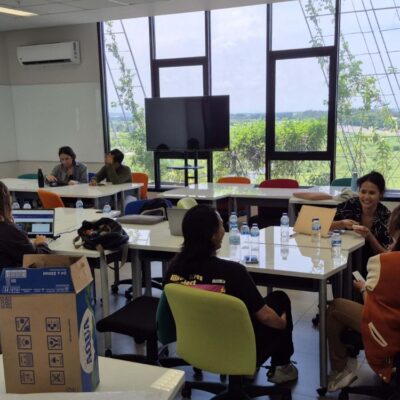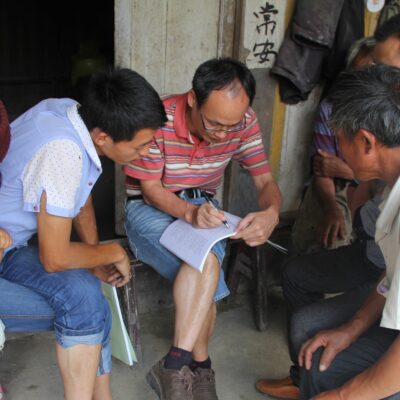Indonesian has been claimed to be a relatively easy language to learn for native speakers of English, partly because it also uses the Roman alphabet. According to the US Department of State’s Foreign Service Institute, it takes approximately 36 weeks or 900 hours to achieve ‘Professional Working Proficiency’ in Indonesian, compared to ‘exceptionally difficult’ languages such as Mandarin Chinese and Japanese, which take approximately 88 weeks or 2,200 hours to achieve a comparable level of proficiency.
Yet, there is a seemingly simple aspect of Indonesian that eludes learners: how to say ‘you’ to an addressee.
Like western European languages such as French, German, Spanish and Italian, Indonesian has more than one form of ‘you’, but unlike these languages and more akin to other languages in East Asia and Southeast Asia, it also has multiple forms for ‘I’ and these are not limited to pronouns. Kin terms from various Indonesian and foreign languages, titles, and names are widely employed. I will focus on the question of ‘you’ in Indonesian.
Deciding which ‘you’ form to use is not always easy for Indonesian language learners because in any given conversation, a speaker needs to consider who their addressee is in relation to them and on what kind of occasion they are speaking. The pervasive use of kin terms, titles and names in Indonesian poses a particular challenge for learners who are unfamiliar with a system that is relatively more complex than English.
In Indonesian, kin terms can be used to refer to the self (i‘I’), the addressee (‘you’) or a third party (‘s/he’), depending on who speaks and to whom. Take kakak ‘older sibling’ and adik ‘younger sibling’ for instance. The statement ‘Kakak tahu adik sakit’ can be translated into English as ‘I know you (younger sibling) are sick’, ‘You know I (younger sibling) am sick’ or ‘The older sibling (s/he) knows that the younger sibling (s/he) is sick’.
Which of the translations is correct depends on whether the statement is uttered by an older sibling to their younger sibling, a younger sibling to their older sibling, or by a person who is reporting to someone that the older sibling knows their younger sibling is sick. Note that Indonesian is not unique in this instance, as a well-known study on Vietnamese by anthropologist Hy Van Luong demonstrates.
Indonesian language textbooks used in Australian schools generally mention that kin terms such as ibu ‘mother’ and bapak ‘father’ are appropriate when speaking to adults, including one’s teacher. Second person pronouns kamu and anda are introduced early in teaching as terms for self-introduction and greeting. This seems simple enough as an introduction to the Indonesian speaker-addressee system, but it doesn’t necessarily properly equip Indonesian language learners with skills to participate in real-life interaction with speakers of Indonesian, which is ultimately the aim of learning the language.
There seems to be a tacit assumption that dramatic simplification of the system is necessary for learners who are practicing language in the limited context that is the classroom. Such an assumption is problematic because the reality is, when learners step out of the classroom, they inevitably encounter people, face-to-face or virtually, in social roles that are not limited to teachers and peers. And if language learning is about developing intercultural skills that enable learners to engage with speakers of the language, then a reductionist approach doesn’t help in achieving this goal. Among other reasons, it engenders a false thinking that social relations expressible in Indonesian are either hierarchical (student-teacher) or flat (peers).
Why kin terms are not just about respect
To clarify the issue, it’s useful to distinguish between addressing and referring to the addressee. In referring to the addressee, the addressee is implicated in what is said. Take the following situation for example. A teacher who saw a colleague carrying a tray of coffee while trying to open their office door, rushed to help the colleague. In return, the colleague said: ‘Thanks, you’re so kind’. In this utterance, ‘you’ refers to the colleague, implicating the person as the one to whom the evaluative phrase ‘so kind’ is intended to apply.
Addressing is the act of nominating someone as the recipient of an utterance. Consider the following situation. A teacher is asking students in the class to each take a turn in reading a text. Turning to a student called Jane, the teacher said ‘Jane, you are next.’ This utterance consists of two main parts: the proper name ‘Jane’ and ‘you are next’. The proper name is being employed to call out the student named Jane, to draw her attention that she (and not Yukiko or Tom, for instance) is the person being spoken to or addressed. The pronoun ‘you’ in the proposition ‘you are next’ refers to Jane and identifies her as the person being instructed to read next.
In Australian schools, it’s common for students to address teachers with ‘Miss’, ‘Mrs’ or ‘Mr’ (with or without name) and to refer to them with ‘you’. It’s in the latter that the problem arises when learners speak Indonesian. Take the simple utterance ‘I gave it to you this morning, Miss.’ To say this in Indonesian, the kinterm ibu ‘mother’ would be used for both the addressee reference ‘you’ and the address term ‘Miss’: Saya sudah berikan ke Ibu tadi pagi, Bu (ibu is commonly shortened into bu when used as an address term).
A common error among learners in this instance is to use the Indonesian pronoun anda as addressee reference instead of the kin term. I discuss below why this pronoun is unsuitable for instances such as this. Further research could help us understand whether the error is simply a result of unfamiliarity with a system that makes use of multiple forms for ‘you’ such as Indonesian, or it’s motivated by an assumption of literal equivalence, that is, an assumption that an utterance containing a pronoun in a source language should also be rendered with a pronoun in the target language.
Anthony Liddicoat and Angela Scarino, writing about intercultural language teaching and learning, emphasise that, in language learning, languages and cultures are not separable, and learners’ linguistic and cultural repertoires interact in complex ways in the process of language learning. They also highlight the point that meaning, or ‘message’, doesn’t reside in linguistic elements alone but crucially includes elements that are not linguistically expressed but are understood through shared knowledge.
The Indonesian kin terms ibu ‘mother’ and bapak ‘father’, when used by students to address their teacher, may be functionally equivalent to English ‘Miss’ and ‘Mister’ in the school context. But these are not two sets of semantically equivalent terms. Ibu and bapak, like the English terms, indicate gender and social status, and when students use them to address their teacher, they invoke asymmetrical, student-teacher role relations. Because of this, the terms have been described in language textbooks as terms that should be used to show respect. But ibu and bapak, unlike ‘Miss’, ‘Mrs’ or ‘Mister’, also denote kin relations and people use them to address and refer to adult addressees in a wide range of occupations, from the president and ministers to teachers, bus drivers, food sellers, home helpers and school caretakers.
When used in the school context, ibu and bapak do not merely identify teachers as individuals of a particular gender and social status but implicate the speaker and addressee as social actors who are related to each other in a web of kin relationships, with all the associations to rights and responsibilities that such relationships are understood to entail.
Kin terms can be used to convey respect but also show feelings of familiarity and affection. As learners progress in their learning and interact more with speakers of Indonesian, they would also find that those terms are used in ways that depart from the norms, so instead of conveying respect, they may use the same kin terms to question others’ actions or to make fun of them.
Given these considerations, the range of kin terms that are taught should extend well beyond those usually employed to convey respect in asymmetrical relations, to include terms learners can use to refer to addressees of different ages and social roles. Apart from enabling learners to extend their language learning beyond the classroom, gaining broader knowledge of cultural practices in which those terms are involved helps to avoid the common fallacy that ibu and bapak are only used when talking to someone older, as has been generally promoted.
Misconceptions often occur in the reductionist approach to teaching about kin terms. For example, an Indonesian teacher told her partner, who does not speak Indonesian, that her students call her ibu, and that the word means ‘mother’. Hearing this, the partner earnestly commented: ‘Your students must respect you so much that they call you ‘mother’.’ This misconception is common among those unfamiliar with Indonesian. Some adult students continue to be uncomfortable when others in the class call them ibu or bapak as they claim it makes them feel old, even as they recognise that these terms are multivalent.
Why reductionism doesn’t work
In Australia, Indonesian is taught against the background of English as the instructional language. The usual way of referring to the addressee in this language is by using the pronoun ‘you’, regardless of the speaker’s or addressee’s age, gender and social status.
Compared to English, Indonesian seems unwieldy because it has multiple pronouns for ‘you’, some are standard forms while others are used mainly in colloquial speech and informal modes of written communication such as text messages and online chats. The question about which ones should be included in teaching material naturally arises. Most textbooks settle for the following pronouns: kamu and anda. A popular textbook used in Australian schools during the late 1980s through to the early 2000s gives the following description for these pronouns.
When you are speaking to somebody and want to say ‘you’, take care to choose the appropriate form of address.
When speaking to children, or intimate friends and relatives, use either: kamu or engkau.
When speaking respectfully to people of a similar age to you, and who you do not know intimately, use either: anda or saudara.
(all bold face and italics in the original)
There is clearly an attempt here to introduce multiple pronouns (though saudara, meaning ‘relative’, is not a pronoun, strictly speaking). However, the instructions are problematic, not least because relations between people that these pronouns are supposed to signify are reduced to just two social dimensions: age and degree of familiarity. To say nothing of the fact that parts of the instructions are simply wrong.
While kamu is indeed a pronoun commonly used to speak to children, among friends or relatives of a similar age, engkau is mainly found in novels, poetry and song lyrics. Imagining a student talking to their peer using this poetic form, one would be forgiven for thinking they are characters in a classic novel. Similarly, it is highly unlikely that a young Indonesian speaker would use anda or saudara to speak to an unfamiliar person of a similar age or younger, regardless of situation (remember this is a textbook for high school students).
The assumption that anda is appropriate to use with strangers of a similar age, as the textbook suggests, is misguided and doesn’t help learners develop knowledge that enables them to be competent participants in social interaction. The same textbook gives the following model conversation for anda. Ibu is an adult female talking to Yanti, a younger female speaker.
Ibu: Siapakah nama anda? (‘What’s your name?’)
Yanti: Nama saya Yanti, Bu. (‘My name is Yanti, Bu.’)
(bold face and translation added)
Anda is a pronoun coined by technocrats in the 1950s as an attempt to have a socially neutral term that citizens of the-then newly independent nation could use to refer to each other as equals. But as anthropologist Joseph Errington observed among Javanese Indonesians he studied, speakers used this pronoun not to mark equality but to identify the addressee as anonymous or absent. Anda, as Errington remarked, has an ‘impersonal character’ and was commonly used in advertising. This pronoun is also widely used in journalistic interviews.
More recent textbooks may not repeat this dramatic error, but the tendency to reduce the various forms for ‘you’ into kamu and anda seems to persist, as can be seen in a recent free online Indonesian language course, and also in samples of student work viewable through the Australian Curriculum website. And so, it continues to be engendered in learners that, in Indonesian, any potential addressee can be identified in stark terms, either as someone familiar (kamu) or socially distant (anda).
To be fair, it must be mentioned that the textbook from which the above examples are taken is only one among several that were used in schools at the time. However, despite variation in the description of ‘you’ across older textbooks, a common approach that prioritised certain forms can be found. This situation is gradually changing with more recent learning resources expanding the range of forms to include sibling terms and proper name.
Rethinking the Indonesian language textbook (and other types of learning material)
What should be done to make sure the complexities of Indonesian addressee-reference system are reflected in the learning material for this language? The present Australian Curriculum (for Languages, Years 7-8) provides useful guidance for this.
In its description for understanding language, the Australian Curriculum recognises that language use varies ‘according to participants, roles and relationships, situations and cultures’ and that registers shift ‘according to familiarity and social position’. It is somewhat unfortunate, however, that this important point is accompanied by examples for register shifts reminiscent of the narrow focus in older texts: ‘using kamu and aku for friends, and Anda, Ibu/Bapak for teachers and adults’.
Notice that the kin terms and pronouns mentioned are precisely those at issue here (with the exception of aku ‘I’, which is a first-person pronoun). Perhaps this is where the opportunity for fine-tuning lies. Rather than mentioning specific terms, the description could identify general principles that underpin interactional norms. If giving specific examples is important, perhaps consideration could be given to a wider range of terms to reflect the variety of social roles people occupy in daily life.
Textbooks could make more room for an explanation that language is used to communicate with people in varied roles, and that in any given interaction, people are likely to refer to their addressee as well as themselves. Introduction to the range of language forms available in Indonesian can follow from this. A more recent textbook currently used at several Australian universities provides an example of how this can be done succinctly. The model could be easily adapted for school texts.
Examples of interaction in which the different forms of ‘you’ are used are valuable in showing learners how the forms they learn in class can be applied in daily situations. Video examples from the New South Wales Department of Education and Communities produced in 2015 include exchanges in which, instead of a pronoun, a personal name is used (such as a student speaking to a fellow student, a school principal speaking to a newly arrived Indonesian student). Examples such as these could provide the basis for metapragmatic discussions to promote awareness of diversity in referring practices.
Learning materials that include model conversations between two adults familiar with each other in which they use ibu and bapak to address and reference each other would also help learners move beyond the stereotyped model of respect. Online material for beginners Indonesian designed by the University of Victoria (Canada) provides an example that could similarly be adapted for schools.
Needless to say, these are only a few among many examples of resources that can help learners develop what scholar Claire Kramsch calls ‘symbolic competence’, that is, the competence to recognise that the discourses that surround people in daily life—from the media to popular culture and conversations—shape their imagination and sensibilities, and which are in turn brought to bear in the process of language learning.
Learning to say ‘you’ is learning to engage with others
So then, to confirm what we already know: saying ‘you’ in many languages involves more than simply choosing which form to use and with whom; it is about learning how social relationships are formed, maintained or broken. In the language class, these relationships have to be imagined and enacted as if real for the purposes of language exercise. Through such exercises learners are introduced to the richness of social life.
Based on this understanding, if the number of forms that should be learned is to be reduced, then such a decision should be based on principles that recognise the diversity of language and cultural practices, as scholars of intercultural language teaching and learning have reminded us. Without such principles, the decision would risk running on the assumption that learners do not have the capacity to deal with a complex system and mistaking complexity with unnecessary difficulty.
Novi Djenar is Associate Professor in Indonesian Studies at The University of Sydney and member of Sydney South East Asia Centre and Sydney Centre for Language Research. She wishes to thank the reviewer for their feedback.
Image: Australian and Indonesian students participate in digital intercultural learning activities. Image credit: Asia Education Foundation, Asialink, the University of Melbourne’.




